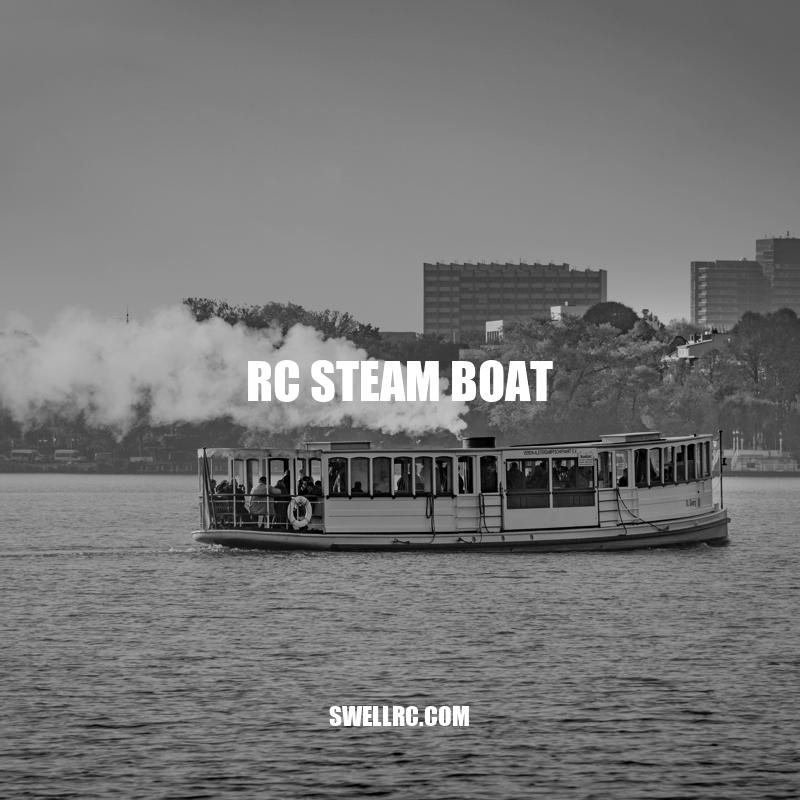RC Steam Boats: Nostalgic Hobby with Working Steam Engine
Remote control (RC) boats have become a popular hobby for many enthusiasts. They come in different styles, sizes, and types, each offering unique experiences and challenges. One of the most fascinating types of RC boats is the RC steam boat. With its working steam engine, an RC steam boat gives a sense of nostalgia and history to your hobby. It harkens back to an era when steamboats were the main mode of transport. RC steam boats offer a unique and exciting experience for hobbyists who want to try something different from the modern electric and gas-powered RC boats. In this article, we will delve into what RC steam boats are, how they work, the different types, benefits, and how to maintain them. Whether you’re a steamboat enthusiast or just looking for a different type of RC boat, this article will provide you with everything you need to know about RC steam boats.
An RC steam boat is a remote-controlled boat that is powered by a miniature steam engine. The steam engine powers the boat, and the water in the boiler turns into steam, which is then used to turn the engine’s pistons. Here’s what you need to know about RC steam boats:
- RC steam boats are unique and exciting for enthusiasts
- They offer a nostalgic experience for those interested in history
- Steamboats have a rich history that mays back to the 1800s
- RC steam boats can range from small-scale models to large-scale models
- They require careful and close monitoring of the steam engine’s temperature and pressure
- Many RC steam boats use radio control to steer and control their speed
RC steam boats can be challenging to operate due to their working steam engines, but this challenge is part of the appeal for hobbyists. It offers a unique level of involvement and control that is not found in other types of RC boats. If you’re interested in building or purchasing an RC steam boat, there are many online resources available for you. We recommend checking out Steamshovelers.net, which has an extensive range of steam engines and RC steam boats, as well as forums for enthusiasts to discuss and share their knowledge and experience.
What are the different types of steam engines?
Steam engines are a type of heat engine that use steam as a working fluid to convert thermal energy into mechanical output. There are several types of steam engines, including:
| Type | Description |
|---|---|
| Reciprocating steam engine | The most common type of steam engine, which uses a piston to convert pressure into motion. |
| Rotary steam engine | A type of engine which uses a rotating motion to generate power. |
| Steam turbine | A type of engine which uses rotating blades to extract energy from the steam. |
If you’re interested in learning more about steam engines, there are many resources available online, including websites like Steam Engine.com, which provides information on various types of steam engines and how they work. Additionally, there are many books available on the topic, such as “The Steam Engine: Its History and Mechanism” by Robert H. Thurston.
Steam Engine Basics
Steam engines are complex machines that rely on heat and pressure to generate power. The steam engine in an RC steam boat is no different, but smaller in scale. Here are some basics to understand how steam engines work in an RC boat:
- The boiler in the boat heats up to generate steam
- The steam travels through a series of pipes or tubes to get to the engine
- The steam enters the engine’s cylinder and pushes a piston back and forth
- The motion of the piston is then transferred to the boat’s propeller via a connecting rod
The temperature and pressure of the steam is critical to the operation of the engine. Too much heat or pressure can cause damage, while too little will not generate enough power to move the boat. It takes skill and practice to master the use of the steam engine in an RC boat.
Here is a breakdown of the components of an RC steam boat’s steam engine:
| Component | Description |
|---|---|
| Boiler | Heats water into steam using a burner or electric heating element |
| Steam Engine | Converts heat from the steam to mechanical energy that powers the boat |
| Piston and Cylinder | The piston moves back and forth in a cylinder, powered by steam, which drives the boat’s propeller |
| Control Valve | Regulates the flow of steam into and out of the engine |
Understanding the components of an RC steam boat’s steam engine makes it easier to maintain and troubleshoot any issues that may arise while operating the boat. You can find various types of RC steam boats and their parts on Horizon Hobby.
How does a steam engine work in a boat?
A steam engine in a boat works by heating water to create steam, which then powers the engine. Here is a simple breakdown of the process:
- Water is heated in a boiler to create steam.
- The steam is then hot enough and under enough pressure to move the pistons in the engine.
- The movement of the pistons powers the propeller, which turns and moves the boat through the water.
Steam engines were once the primary form of propulsion for boats, but they have since been largely replaced by more efficient and eco-friendly methods.
If you are interested in learning more about steam engines and their history, there are many websites dedicated to the topic. The Steam Boat Association of Great Britain and Steamboats.org are both great resources for information and enthusiasts.
Benefits of RC Steam Boats
Owning an RC steam boat has many benefits that make it a unique and enjoyable hobby. Here are some of the benefits of owning an RC steam boat:
- Nostalgia – Many RC steam boat enthusiasts appreciate the historical significance of steam engines and enjoy reliving a bygone era through RC boat ownership.
- Simplicity – RC steam boats have fewer electronic components compared to other RC boats, making them easier to operate and maintain.
- Cool Factor – RC steam boats are undeniably cool. Not only do they look great, but the sound of the steam engine and the smell of the burning fuel make for a sensory experience that can’t be matched by other RC boats.
- Community – There is a strong and passionate community of RC steam boat enthusiasts who love to gather and share knowledge and experiences. It’s a great way to meet new friends who share your passion for RC boats.
There are many websites and online forums dedicated to RC steam boat hobbyists. These resources offer tips and advice on everything from building your own RC steam boats to powering and maintaining existing boats. Websites like Steam Tug and Stewart Models offer a wide range of RC steam boat kits and accessories for those who prefer to build their own boats.
What is the advantage of a steam boat?
Steam boats were once a typical mode of transportation used in the 19th and early 20th centuries. Although their popularity has waned, steam boats still offer some advantages, which includes:
- Steam boats are ideal for travel on rivers and in shallow waters where other types of vessels cannot operate.
- They are fueled by coal, which is readily available and less expensive compared to oil or gas.
- Steam boats are less expensive to maintain and require fewer crew members to operate.
- They emit less noise pollution and are more environmentally friendly compared to other vessels.
For those interested in learning more about steam boats, sites such as Steamboats.org and American Queen Steamboat Company offer information and tours of historic steam boats still in operation today.
Types of RC Steam Boats
RC steam boats come in a range of sizes, styles, and designs that cater to various preferences and skill levels. Here are a few of the most common types of RC steam boats:
- Classic Steam Launch – This is the quintessential steam boat design, featuring a white hull, red trim, and a tall smokestack. These boats can range in size from mini to full-scale and are ideal for beginners.
- Tugboat – Steam-powered tugboats are another popular option. Their compact size makes them easy to transport, and their powerful engines make towing other boats a breeze.
- Racing Boat – For those who love speed, there are RC steam racing boats. These boats are built for speed and come in a range of designs, from sleek and modern to vintage and classic.
- Live Steam Launch – These boats are designed to operate like full-scale steamboats and feature all the components and accessories of a real steamboat, such as a whistle, steam engine, and water tank. They require a higher level of skill to operate and maintain and are typically more expensive.
There are many websites and online stores that cater to RC steam boat enthusiasts. Popular websites include Model Steam, Model Dockyard, and Bailey’s Marine Fuels, which offer a range of kits and accessories for building and maintaining RC steam boats. These websites also offer a wealth of information, tips, and advice on everything from picking the right boat to choosing the right fuel.
What are the different types of steam boats?
Steam boats have played an important role in transportation, trade and commerce throughout history. Here are a few different types of steam boats that have been used over the years:
| Type of steam boat | Description |
|---|---|
| Paddle wheel steamboat | A steamboat that uses paddle wheels on either side of the boat to propel itself through the water. |
| Screw propeller steamboat | A steamboat that uses a screw propeller at the back of the boat to propel itself through the water. |
| Barge steamboat | A steamboat that is designed to transport cargo on a barge or flat-bottomed boat. |
If you’re interested in learning more about steam boats, check out the Steamboat Historical Society of America website or the Steamboat Natchez product page for a riverboat tour experience.
How to Maintain an RC Steam Boat
Keeping your RC steam boat well-maintained is essential to ensure optimal performance and longevity. Here are some tips for caring for your RC steam boat:
- Clean your boat after each use with mild soap and water to remove any dirt or debris.
- Inspect your boat regularly for any signs of damage or wear and tear, such as cracks or leaks.
- Oil all moving parts to prevent rust and corrosion.
- Drain the water tank and boiler after each use to prevent buildup.
- Store your boat in a cool, dry place away from direct sunlight and moisture.
- Use only high-quality fuels and lubricants designed for RC steam boats.
If you’re new to RC steam boating, it’s a good idea to consult online forums or websites for tips and advice on maintenance. There are also plenty of online resources that offer replacement parts, tools, and accessories, such as Model Steam and The Steam Boat Association. By taking good care of your RC steam boat, you can enjoy hours of sailing fun and preserve the heritage and history of steam-powered vessels.
What Maintenance Does a Boat Need?
Maintaining a boat is crucial to ensure its longevity and safety on the water. Here are some of the basic boat maintenance tasks that every boat owner should know:
- Clean the boat regularly with soap and water to remove salt and grime.
- Check the boat’s electrical system and wiring for any damages or loose connections. Replace any damaged parts.
- Check the oil and fluid levels regularly and change the oil and filters according to the manufacturer’s recommendations.
- Inspect the propeller for damage or wear and replace it if necessary.
- Check the hull and the deck for any cracks, holes, or soft spots and repair them to avoid leaks.
For a more detailed list of boat maintenance tasks, check out the website of the BoatUS Foundation or the Marine Maintenance Guide from West Marine. They offer comprehensive guides and information to help you keep your boat in top shape.
Conclusion
RC steam boats offer a unique and rewarding hobby experience for enthusiasts. With their elegant design and nostalgic charm, they capture the essence of vintage steam boats while incorporating modern RC technology. Owning an RC steam boat can provide a relaxing and enjoyable outdoor activity that can be enjoyed alone or with friends and family. By following the tips for maintenance, you can ensure that your boat runs smoothly and has a long lifespan. There are many resources available online, such as forums and specialty stores, that can help you learn more about the fascinating world of RC steam boating. Consider investing in an RC steam boat and embark on a journey of fun and adventure today!



